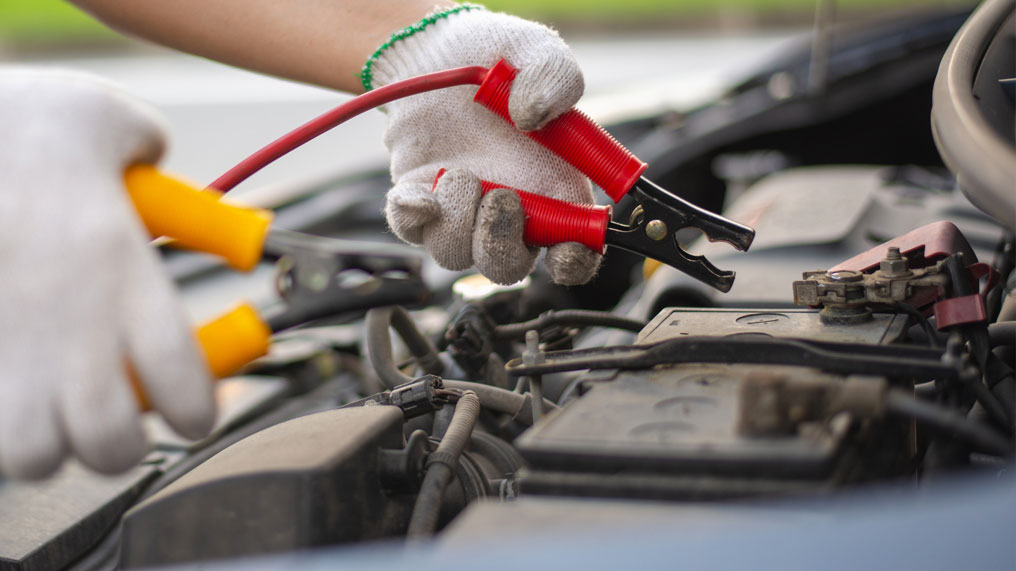There’s never a good time for your car not to start. However, being able to jump-start a car will help take the worry out of the situation should you turn the key to find your battery has died.
We’ve created this handy guide to tell you what you should and shouldn’t do when your car won’t start, and most importantly, how to get you back up and running.
Before trying to jump-start the car
First of all, don’t leap straight in. If you’re feeling stressed out, you may not be paying full attention to your personal safety, so it’s important to keep a cool head.
If your car’s parked anywhere other than a private driveway or garage, look out for traffic and other hazards at all times. Before doing anything else, ensure the lights and electronics are off and remove the key from the ignition.
Then, once you’ve popped open and secured the bonnet, inspect the battery without touching it at this stage. For your safety, be sure to stick to the following rules:
-
DON’T poke around or touch the battery with anything metal.
-
DON’T attempt to jump-start a battery which is damaged, leaking or has signs of corrosion. Call an expert.
-
DON’T smoke or go anywhere near the engine with a naked flame.
-
DON’T go near the engine wearing loose clothing, including scarves, jewellery and so on.
-
DO make sure that your car is of the type that can be jump-started. Some vehicles, such as those with electric ignition systems, shouldn’t be started this way.
How to use jump leads
You’ll need a set of jump leads (also called jumper cables) that are in good working order and a car owner who’s willing to lend you a hand, or more precisely the use of a car battery. In all likelihood, the battery will be 12 volts, but do check – it must be the same voltage as yours.
-
Park both cars within easy reach of each other.
-
Have the handbrakes on and the ignitions off.
-
Use the red jump lead to connect the positive terminals of the two batteries (the one marked +). Start with the WORKING battery, and then connect the flat battery.
-
Connect one end of the black jump lead to the negative terminal (the one marked -) of the working battery.
-
Attach the other end of the black jump lead to an earthing point on the car with the flat battery. Look for an area of unpainted metal, well away from the battery and any fuel.
-
Make sure the leads aren’t close to any moving parts.
-
Wait a few minutes and then start the engine of the working car. Let it run for a minute before starting your own car. If your car doesn’t start, wait a little longer and try again, checking that the leads aren’t getting too hot.
-
Leave the two cars running for 10 minutes or so, keeping an eye on both vehicles.
-
Turn off both engines.
-
Remove the jump leads carefully in the REVERSE order they were connected. Don’t let the leads touch each other.
-
Restart your engine.
What to do after the car has started to recharge the battery
If a flat battery is the only problem, then driving for about 10 minutes at around 2,000 rpm is likely to provide enough charge to let you start the car next time you need to use it (it’s not guaranteed though and depends on a wide range of factors).
The job of your car’s alternator isn’t to recharge the battery though, so much as keep it topped up. A much better idea than trying to fully recharge just by driving around is to invest in a battery charger. These are inexpensive and a great addition to any driver’s toolkit.
To ensure that the problem really is just with your battery and not with something else (such as your car’s alternator) it’s advisable to get your car looked at as soon as possible.
Also, be aware that a full discharge can damage the battery’s life – another reason to take the car to a local garage for a health check.
What if jump-starting doesn’t work?
If jump-starting doesn’t work, it’s worth trying again with another set of jump leads (if easily available). If the cables are fine, then the chances are there’s something else wrong. It could still be something simple such as dirty or loose connections, so check that everything looks to be in good order.
A worn-out starter motor is the next most likely cause of not being able to jump-start a car, followed by some other electrical components being at fault. A less likely but very serious possible cause is that the engine has seized up. If this is the case, it will make a single clicking or thudding sound when you try to fire it up.
Ultimately, if you’re not sure what the problem is, or are uncertain at all about trying to fix the problem yourself, call in the professionals.
Next time, take the stress out of a breakdown with breakdown cover.




